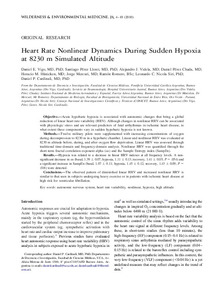Por favor, use este identificador para citar o enlazar este ítem:
https://repositorio.uca.edu.ar/handle/123456789/1637| Título: | Heart rate nonlinear dynamics during sudden hypoxia at 8,230 m simulated altitude | Autor: | Vigo, Daniel Eduardo Pérez Lloret, Santiago Videla, Alejandro J. Pérez Chada, Daniel Hünicken, Horacio M. Mercuri, Jorge Romero, Ramón Nicola Siri, Leonardo C. Cardinali, Daniel Pedro |
Palabras clave: | SISTEMA NERVIOSO AUTONOMO; FRECUENCIA CARDIACA; HIPOXIA; ALTITUD; ESTUDIO DE CASOS | Fecha de publicación: | 2010 | Editorial: | Elsevier | Cita: | Vigo, D. E., et al. Heart rate nonlinear dynamics during sudden hypoxia at 8230 m simulated altitude [en línea]. Wilderness & Environmental Medicine. 2010, 21 (1). doi:10.1016/j.wem.2009.12.022. Disponible en: https://repositorio.uca.edu.ar/handle/123456789/1637 | Resumen: | Abstract: Acute hypobaric hypoxia is associated with autonomic changes that bring a global reduction of linear heart rate variability (HRV). Although changes in nonlinear HRV can be associated with physiological stress and are relevant predictors of fatal arrhythmias in ischemic heart disease, to what extent these components vary in sudden hypobaric hypoxia is not known. Methods: Twelve military pilots were supplemented with increasing concentrations of oxygen during decompression to 8,230 m in a hypobaric chamber. Linear and nonlinear HRV was evaluated at 8,230 m altitude before, during and after oxygen flow deprivation. Linear HRV was assessed through traditional time- and frequency- domain analysis. Nonlinear HRV was quantified through the short term fractal correlation exponent alpha (αs) and the Sample Entropy index (SampEn). Results: Hypoxia was related to a decrease in linear heart rate variability indexes at all frequency levels. A non significant decrease in αs (basal: 1.39 ± 0.07, hypoxia: 1.11 ± 0.13, recovery: 1.41 ± 0.05, p = 0.054) and a significant increase in SampEn (basal: 1.07 ± 0.11, hypoxia: 1.45 ± 0.12, recovery: 1.43 ± 0.09, p = 0.018) were detected. Conclusions: The observed pattern of diminished linear heart rate variability and increased nonlinear heart rate variability is similar to that seen in subjects undergoing heavy exercise or in patients with ischemic heart disease and high risk for ventricular fibrillation. | URI: | https://repositorio.uca.edu.ar/handle/123456789/1637 | Disciplina: | MEDICINA | DOI: | 10.1016/j.wem.2009.12.022 | Derechos: | Acceso Abierto | Fuente: | Wilderness & Environmental Medicine. 2010, 21 (1) |
| Aparece en las colecciones: | Artículos |
Ficheros en este ítem:
| Fichero | Descripción | Tamaño | Formato | |
|---|---|---|---|---|
| heart-rate-dynamics-during-hypoxia.pdf | 233,84 kB | Adobe PDF |  Visualizar/Abrir |
Visualizaciones de página(s)
149
comprobado en 30-abr-2024
Descarga(s)
149
comprobado en 30-abr-2024
Google ScholarTM
Ver en Google Scholar
Altmetric
Altmetric
Este ítem está sujeto a una Licencia Creative Commons

